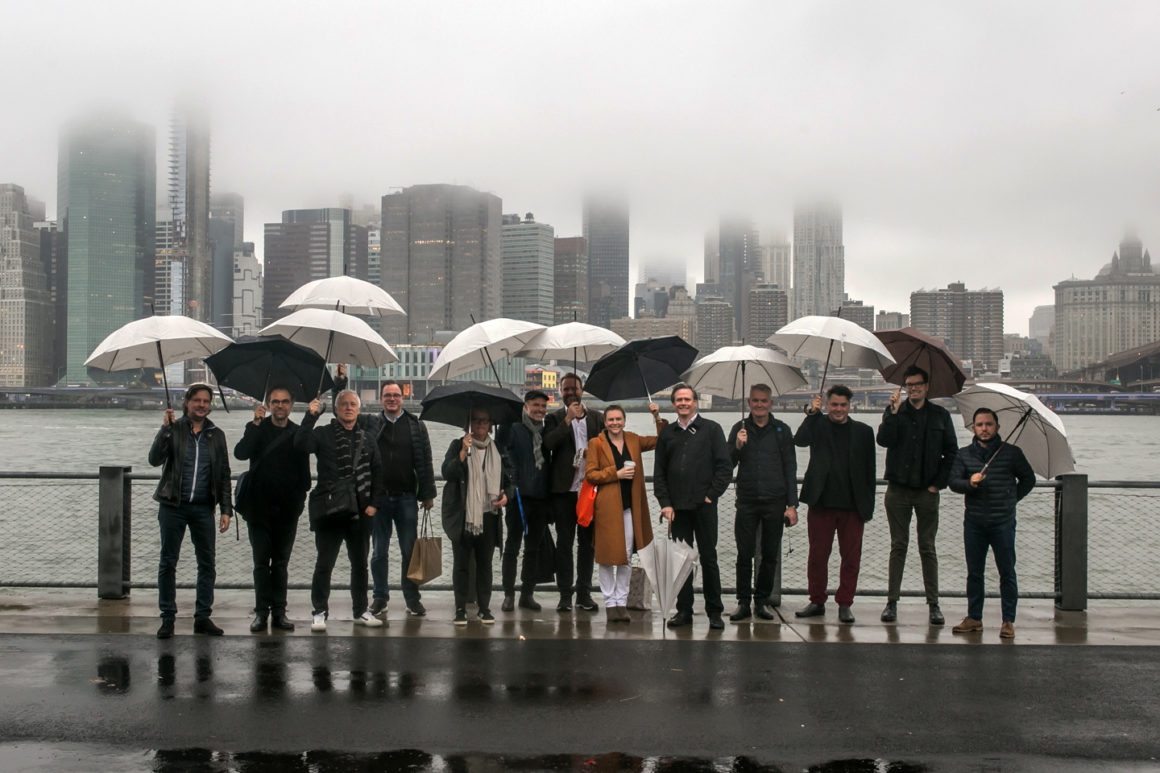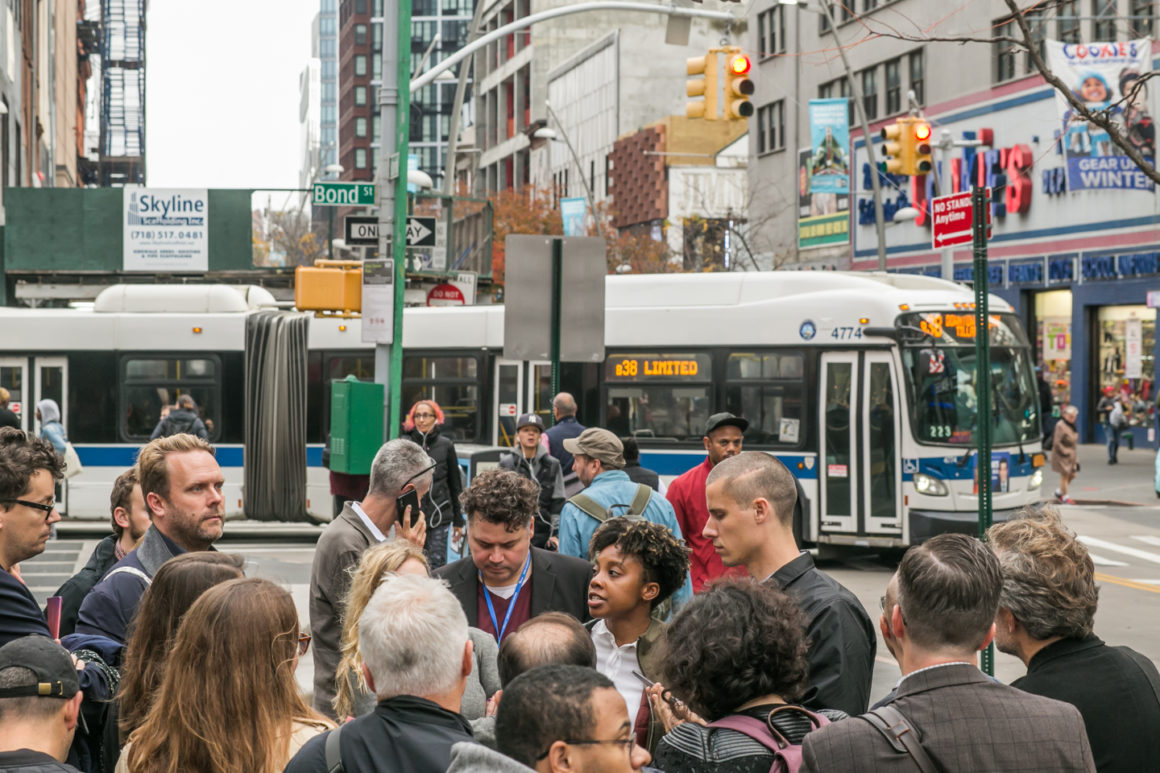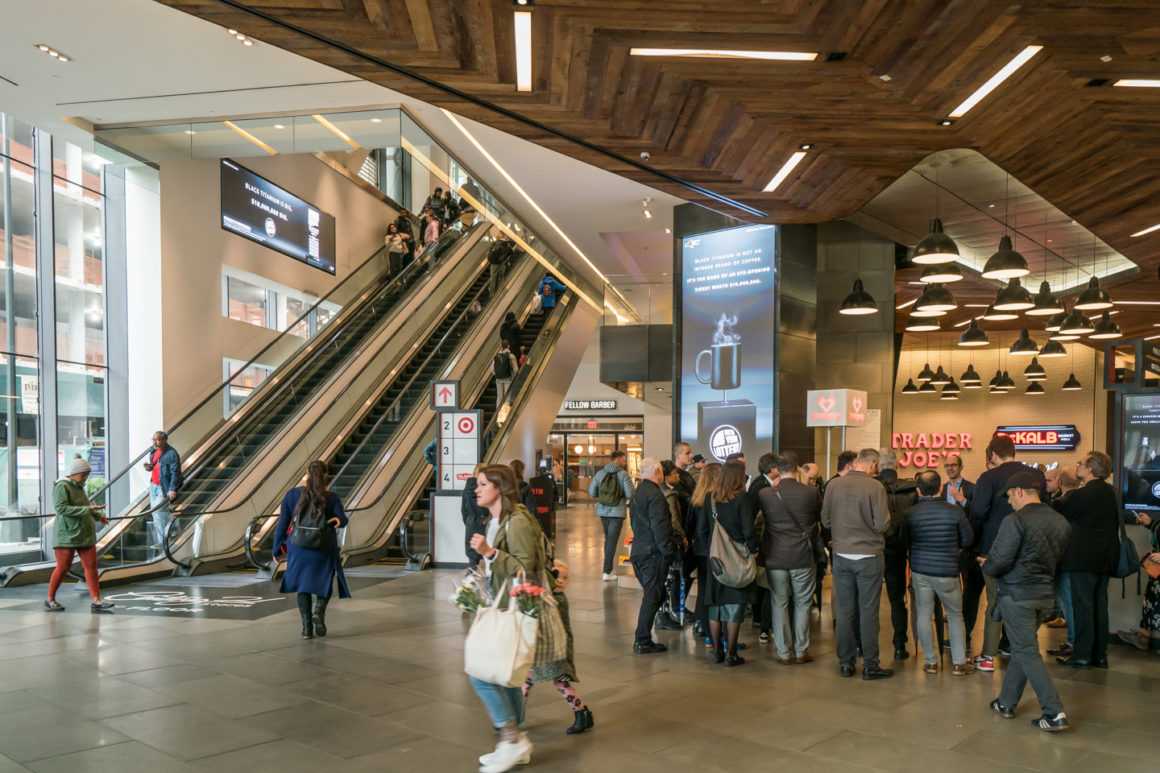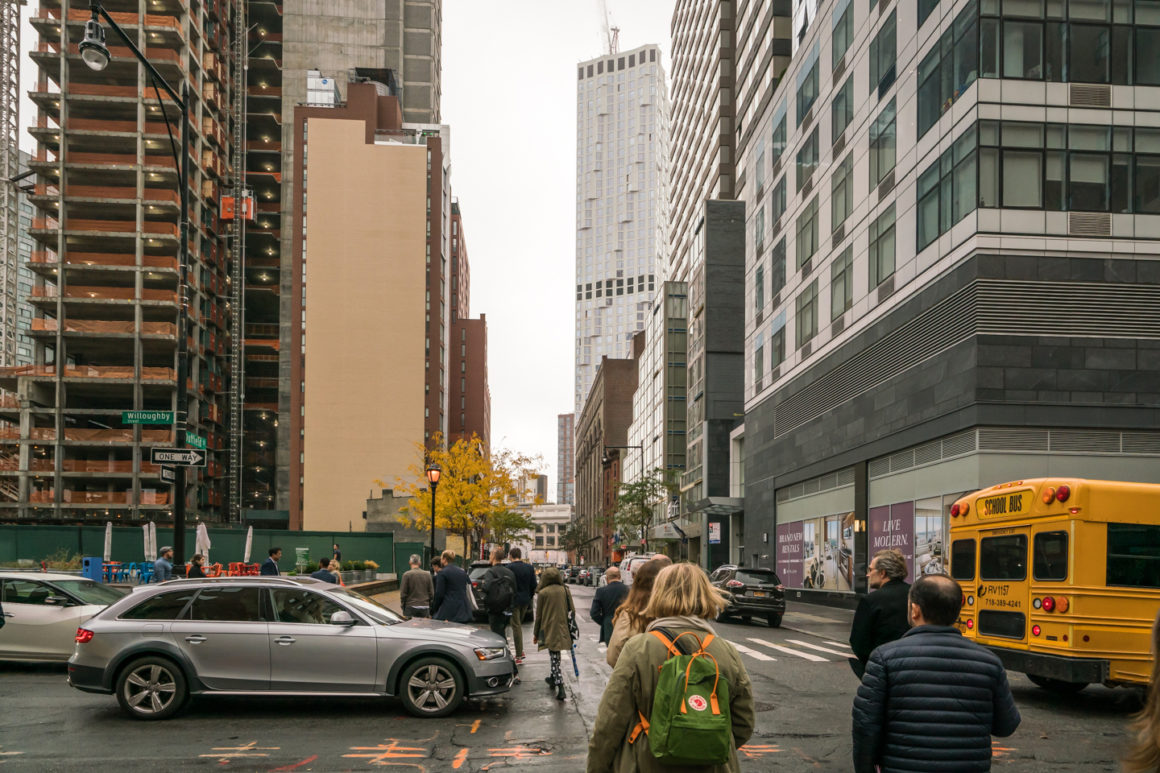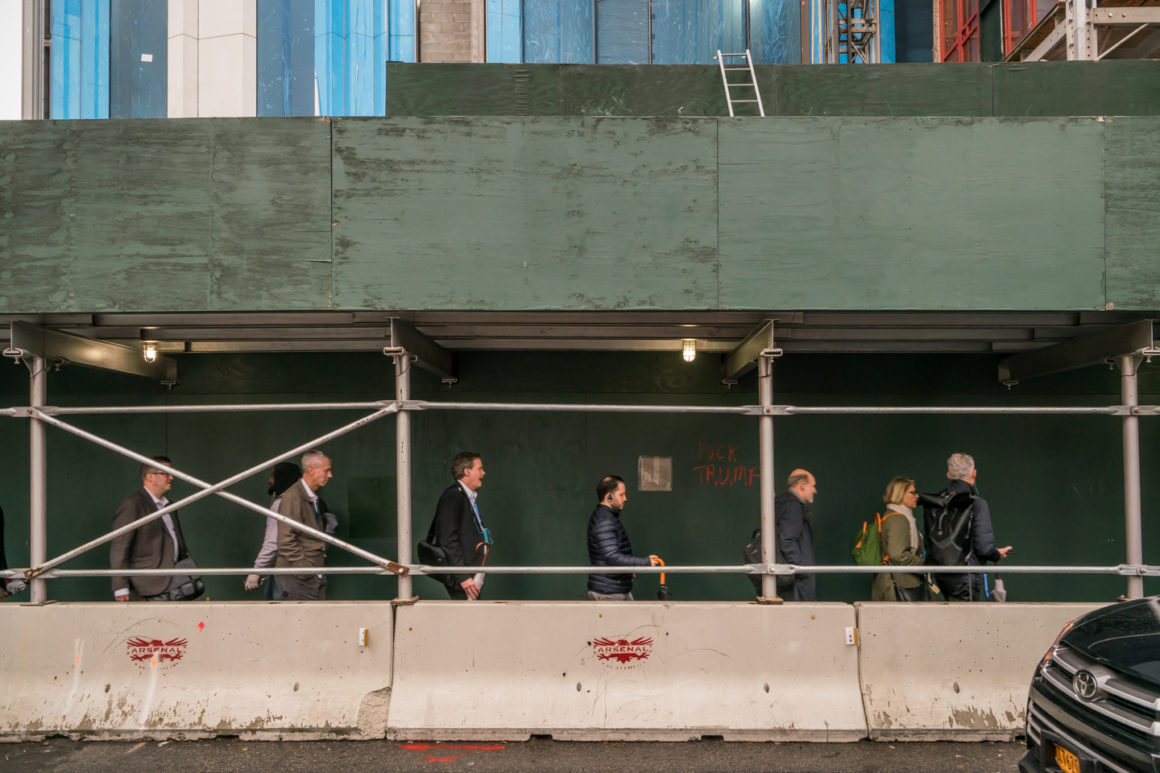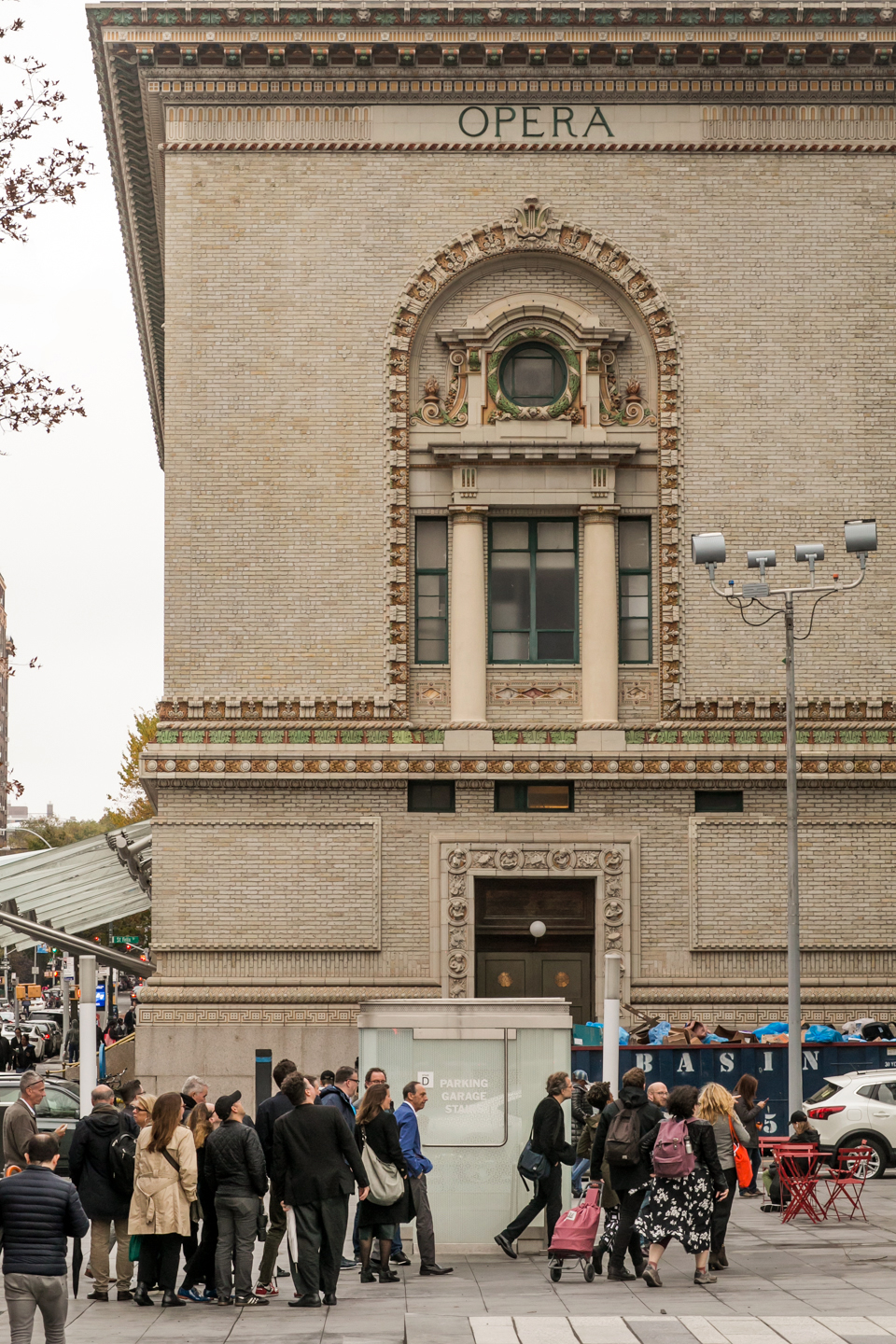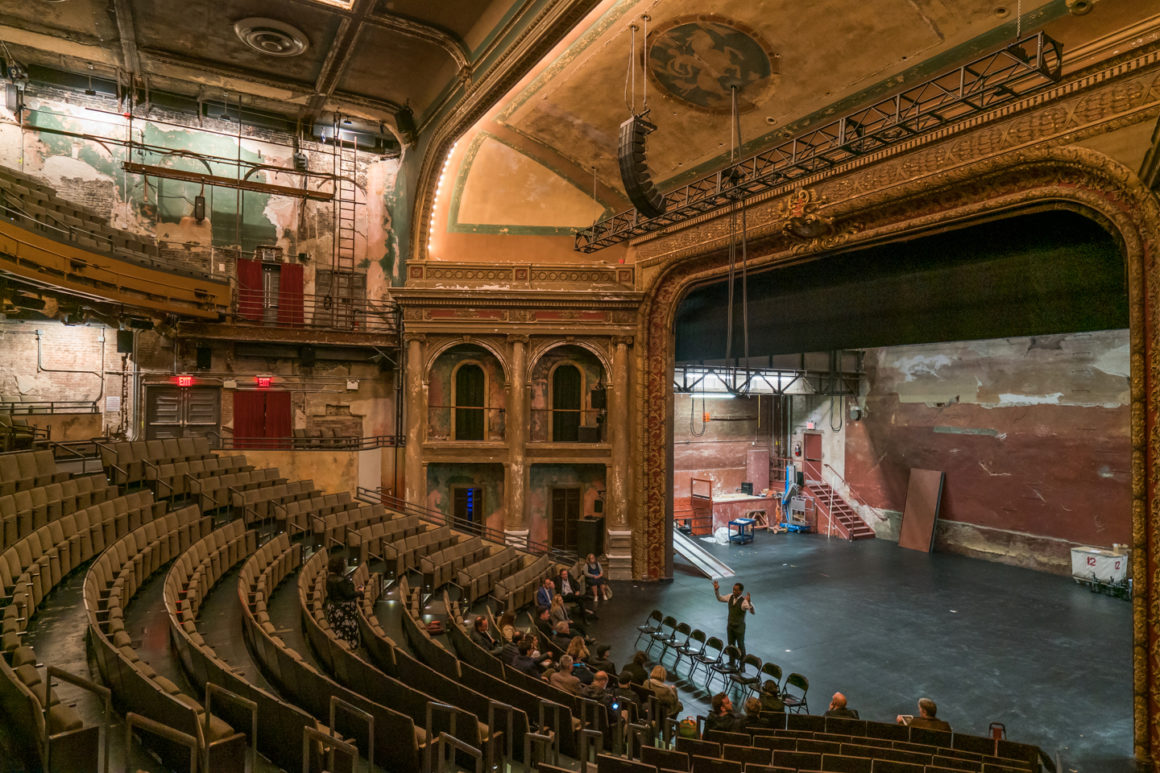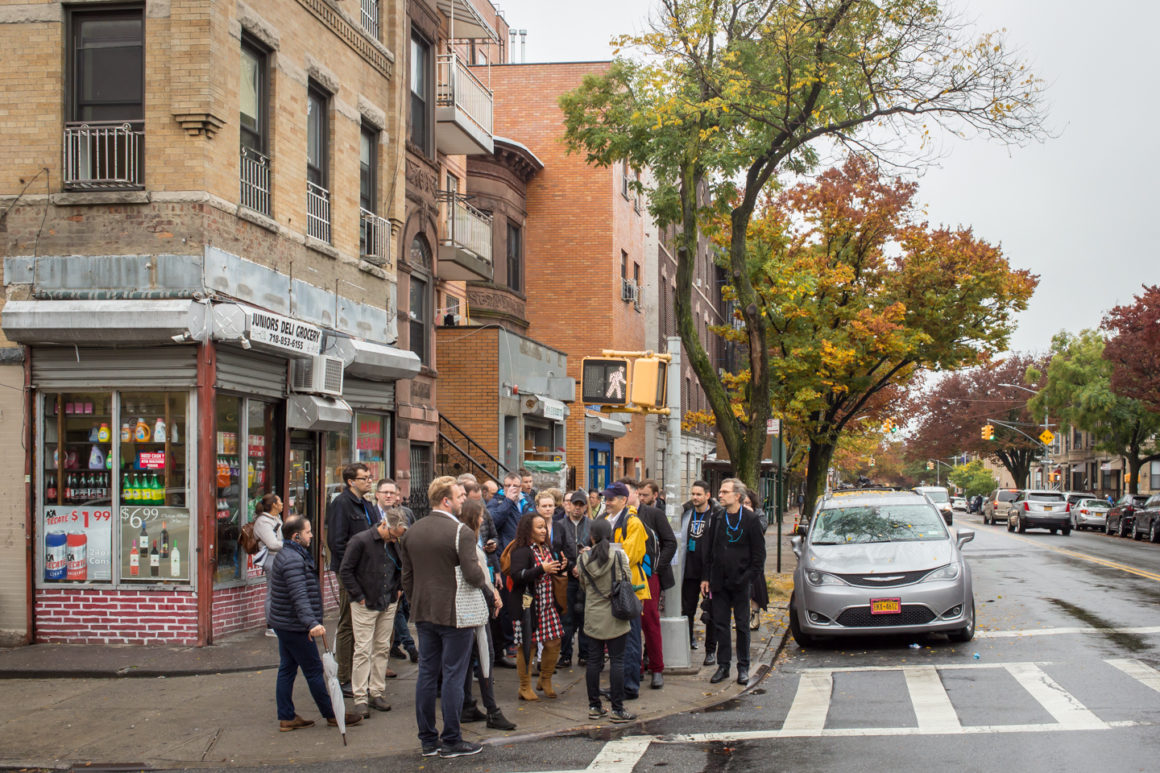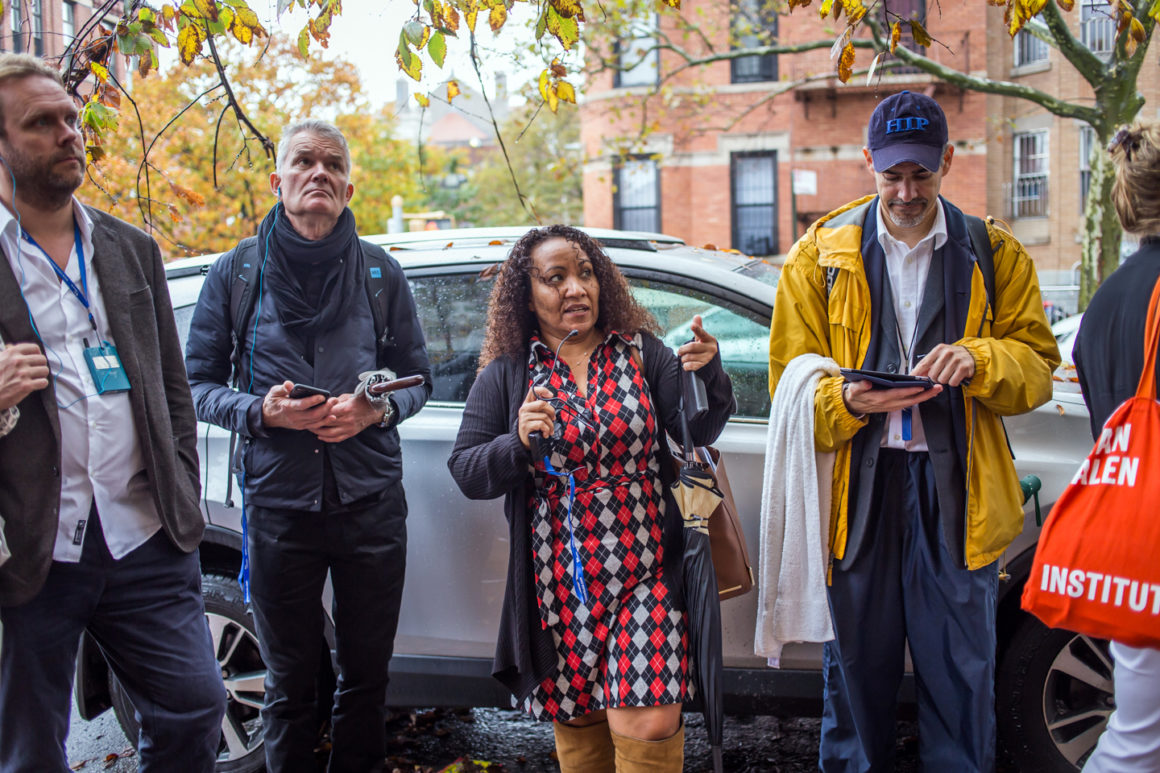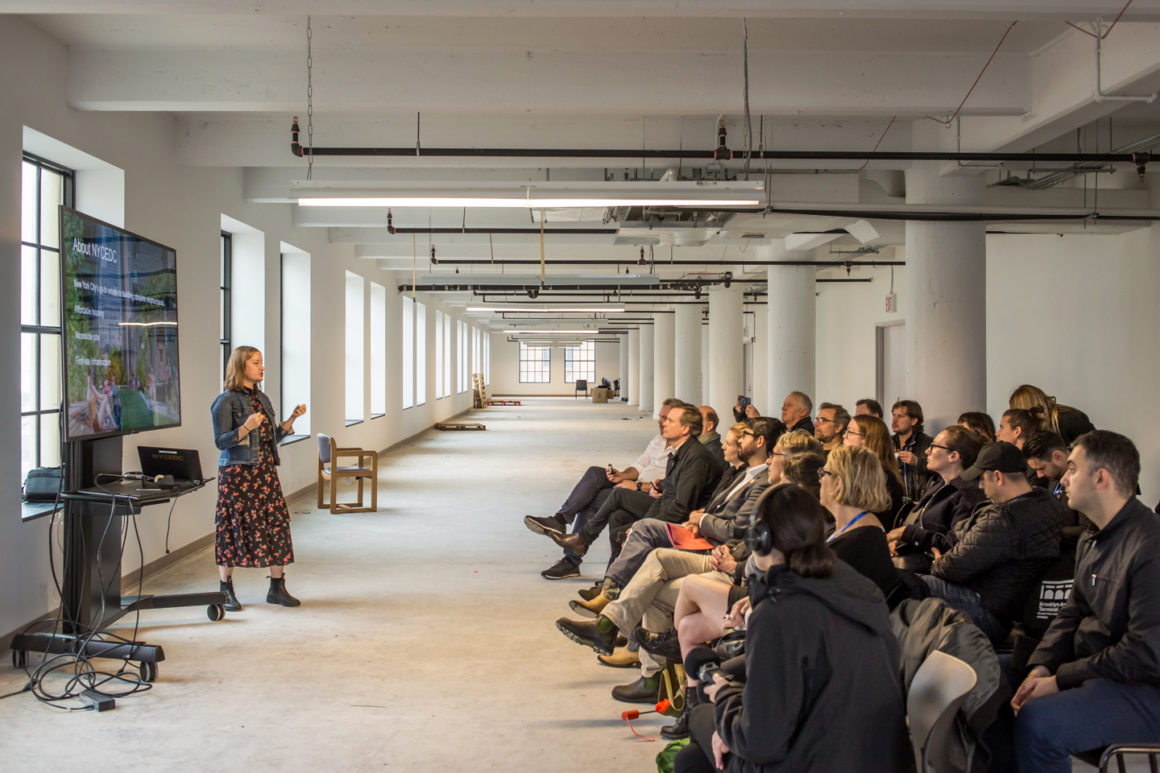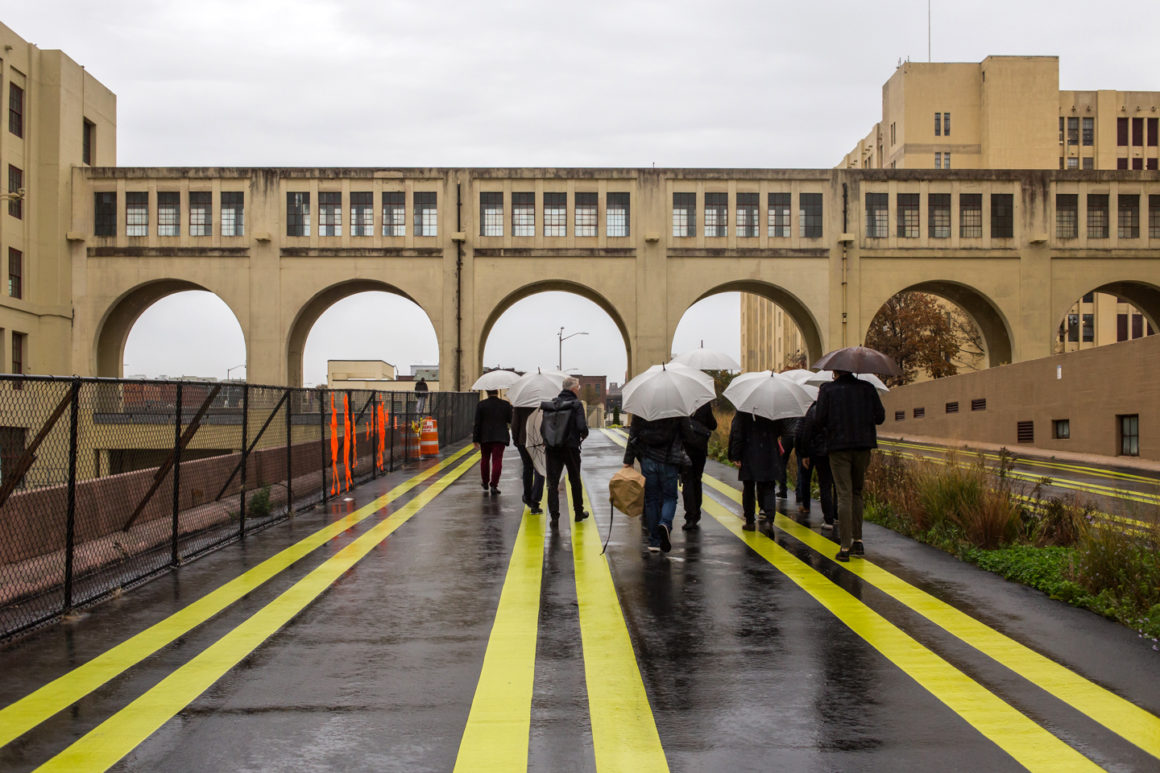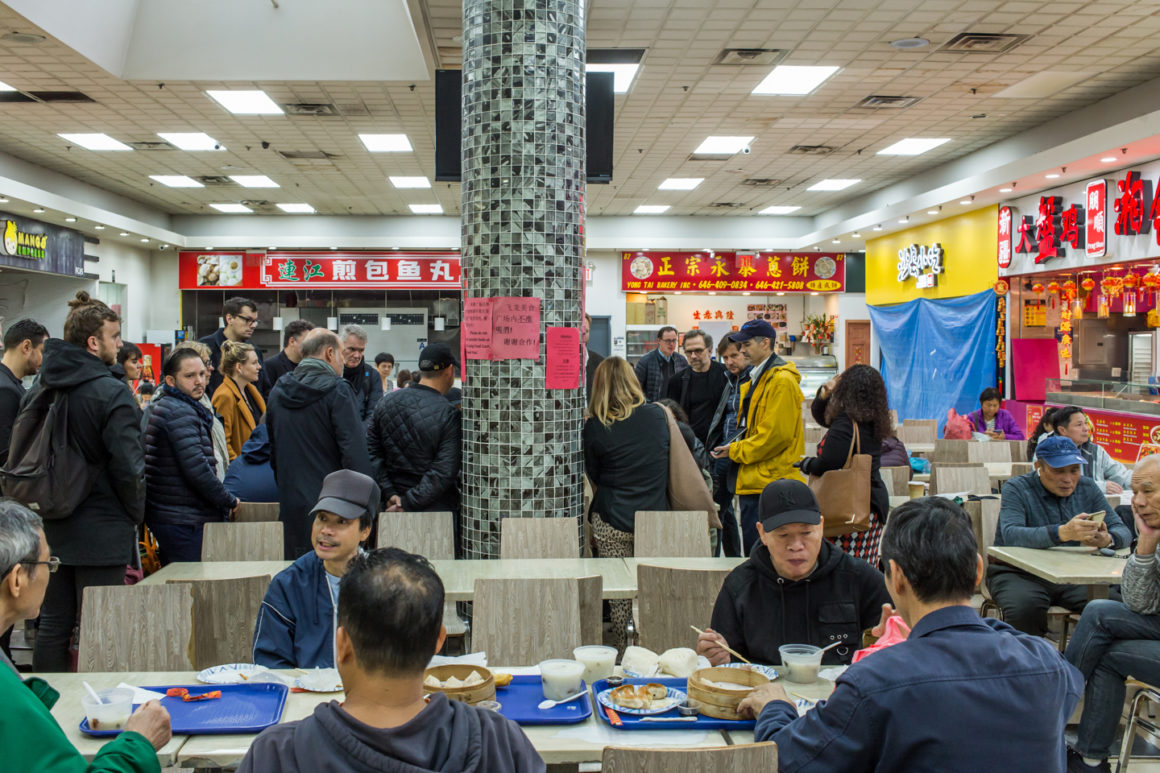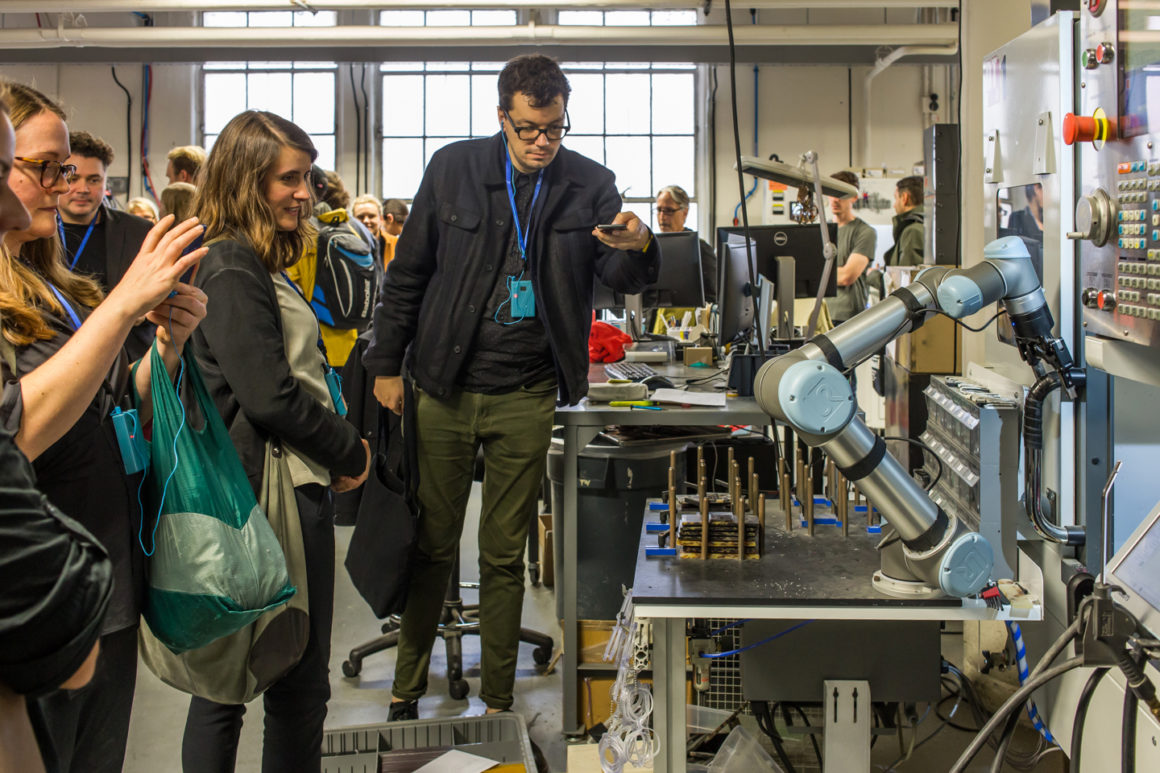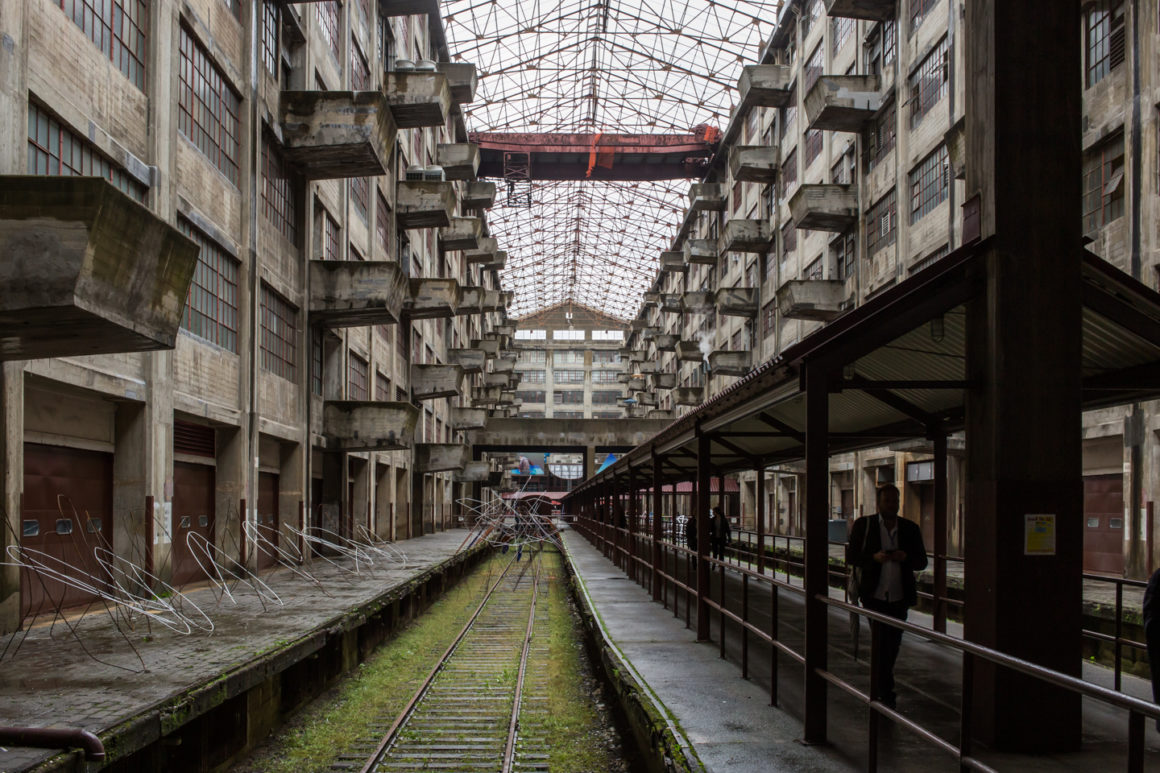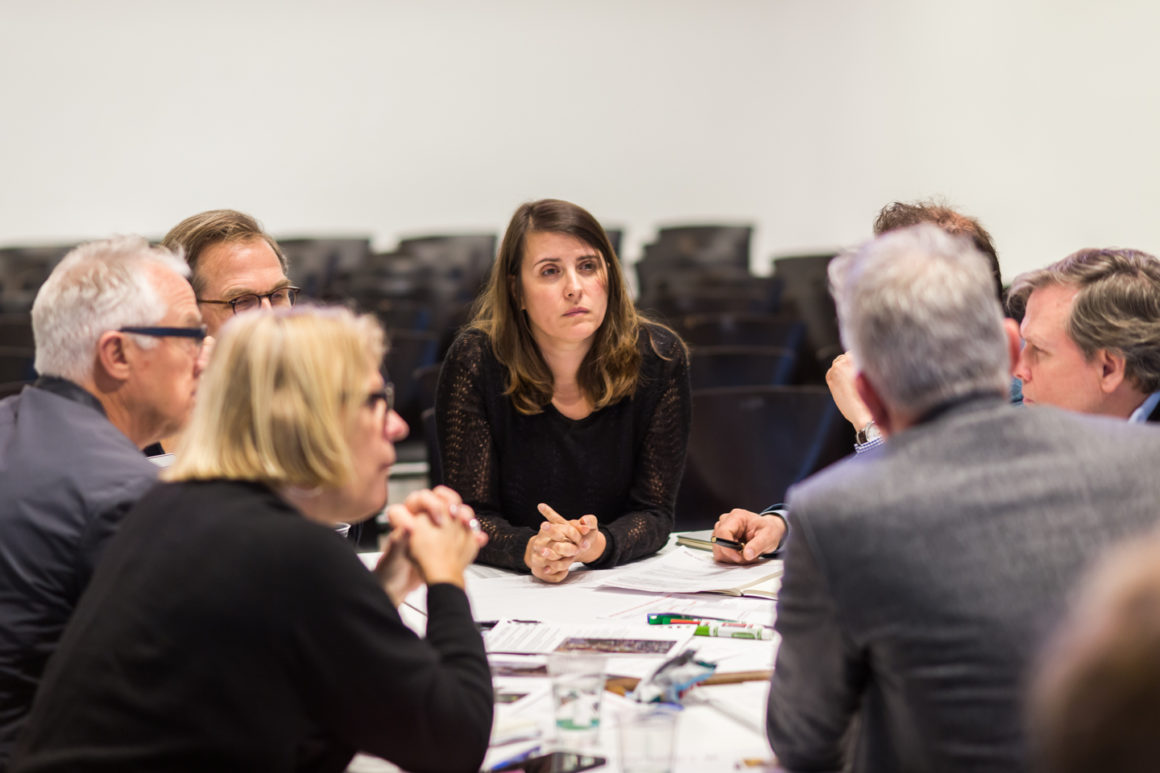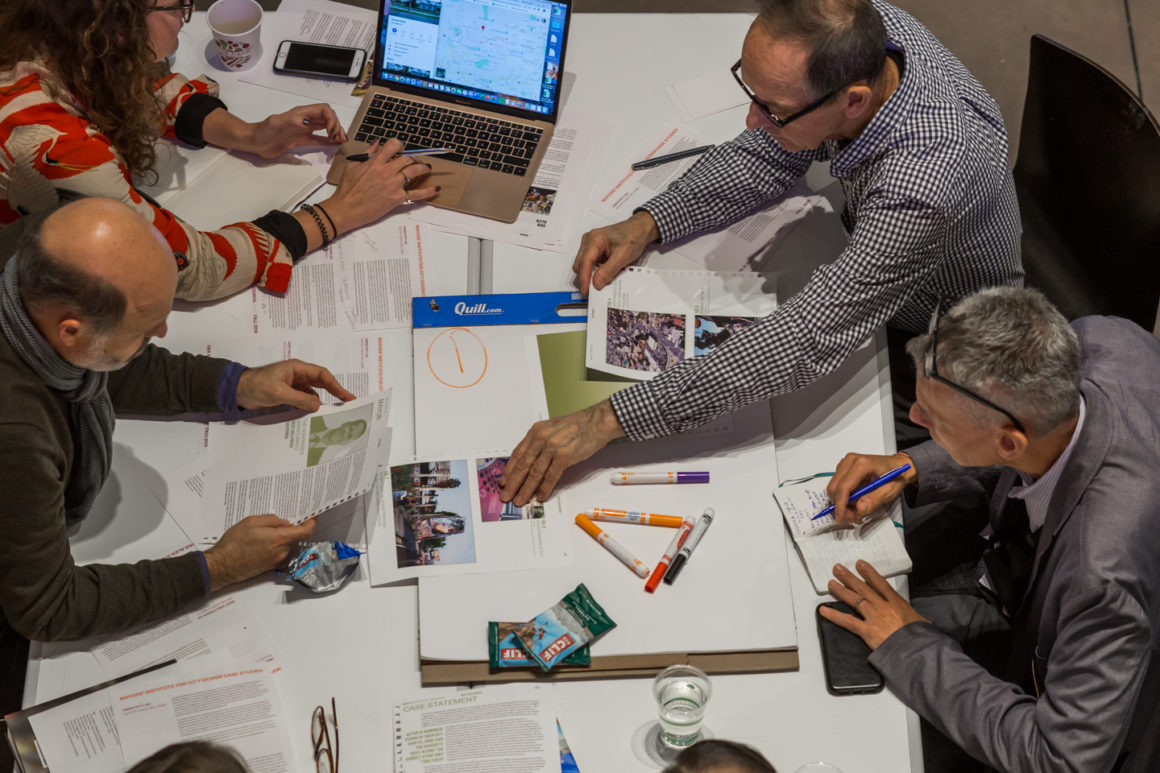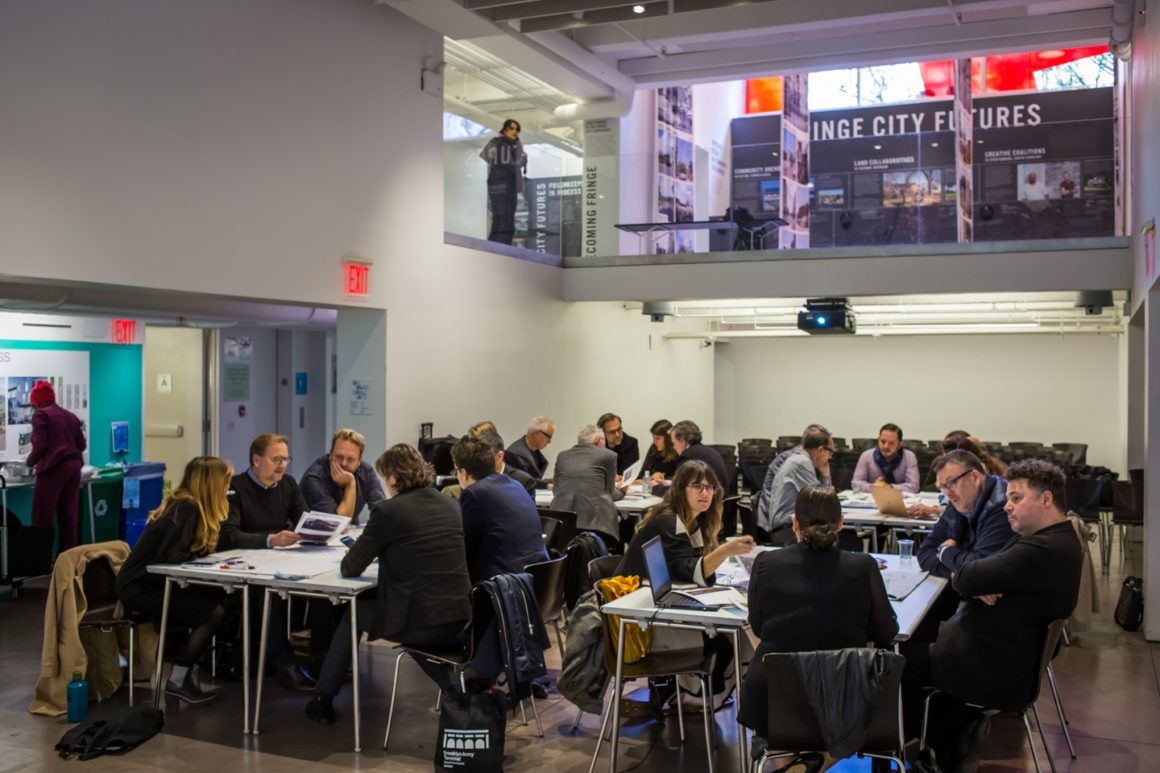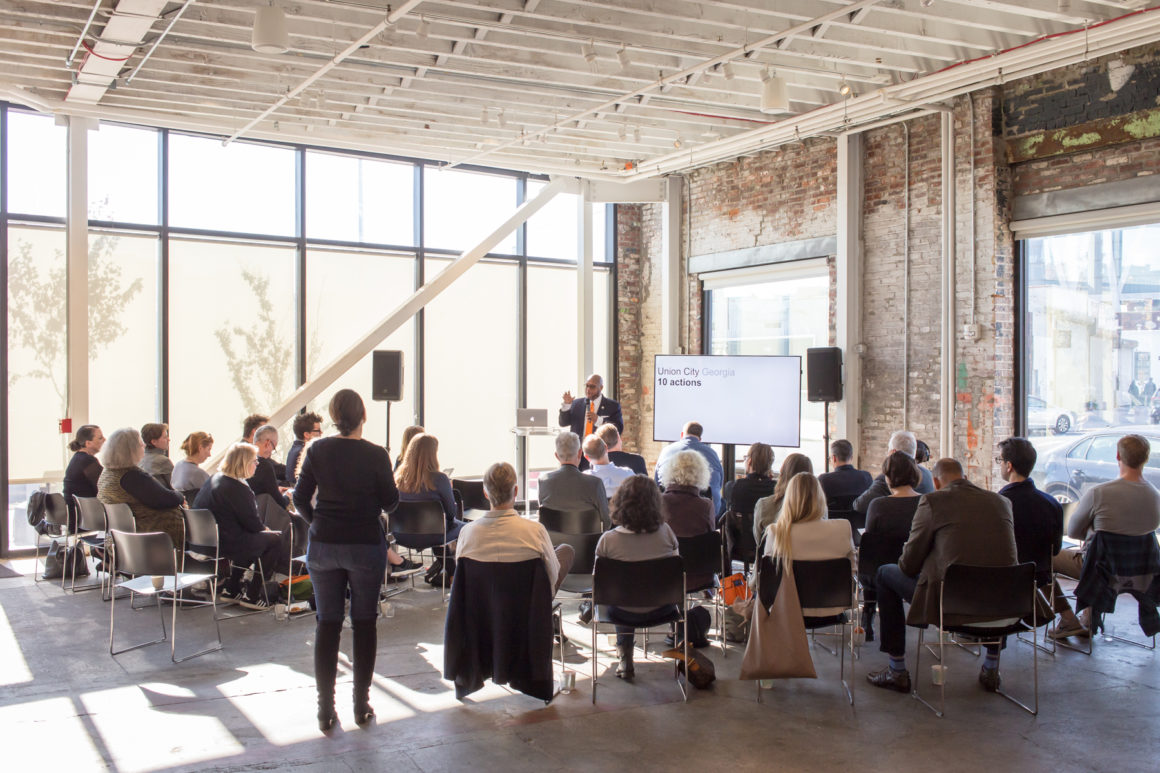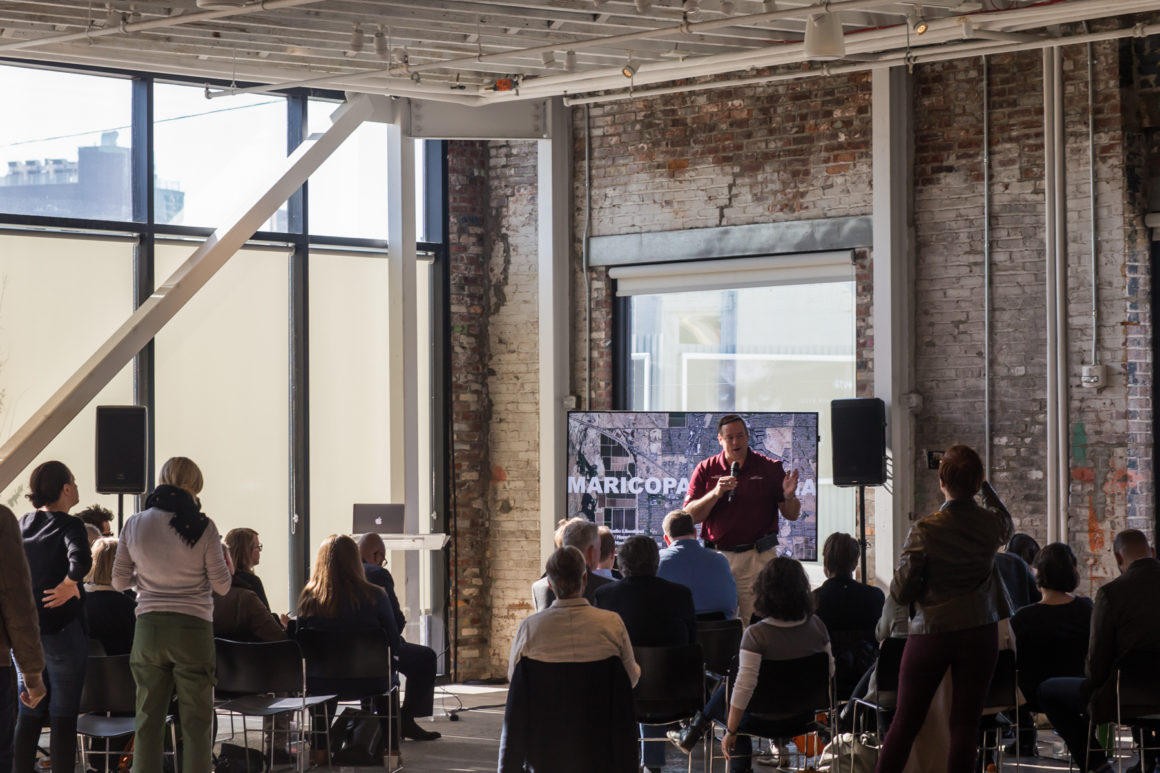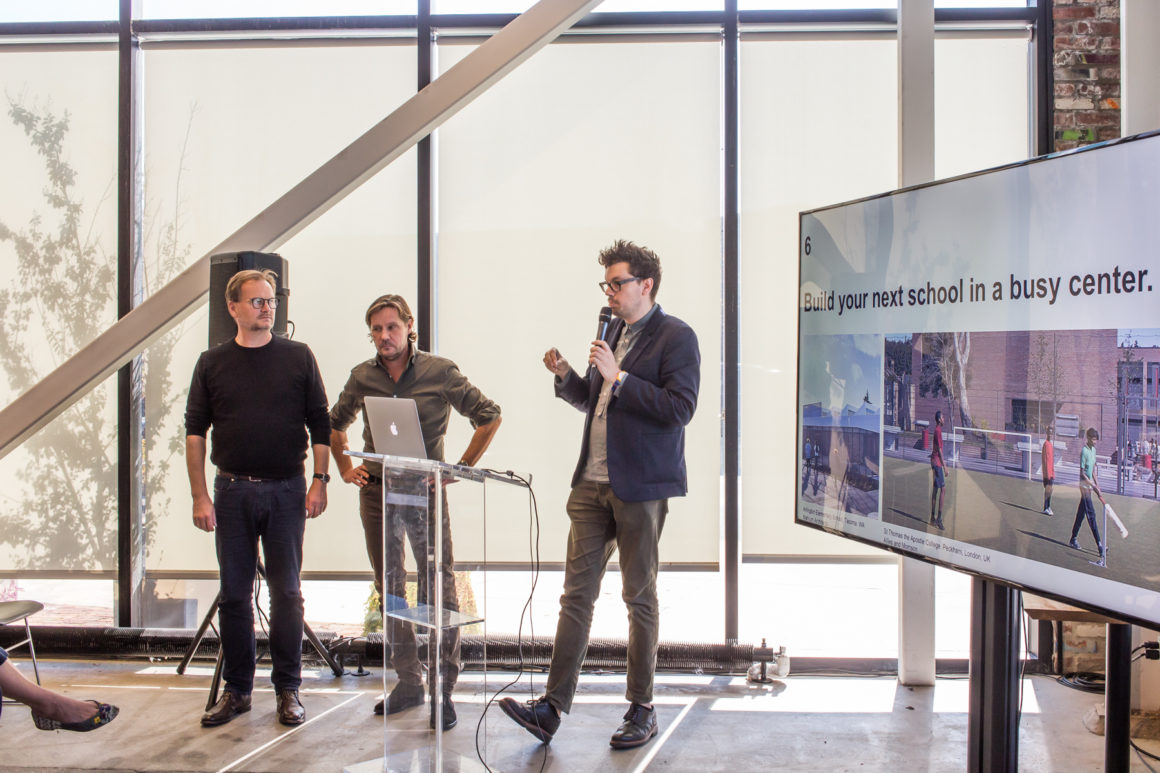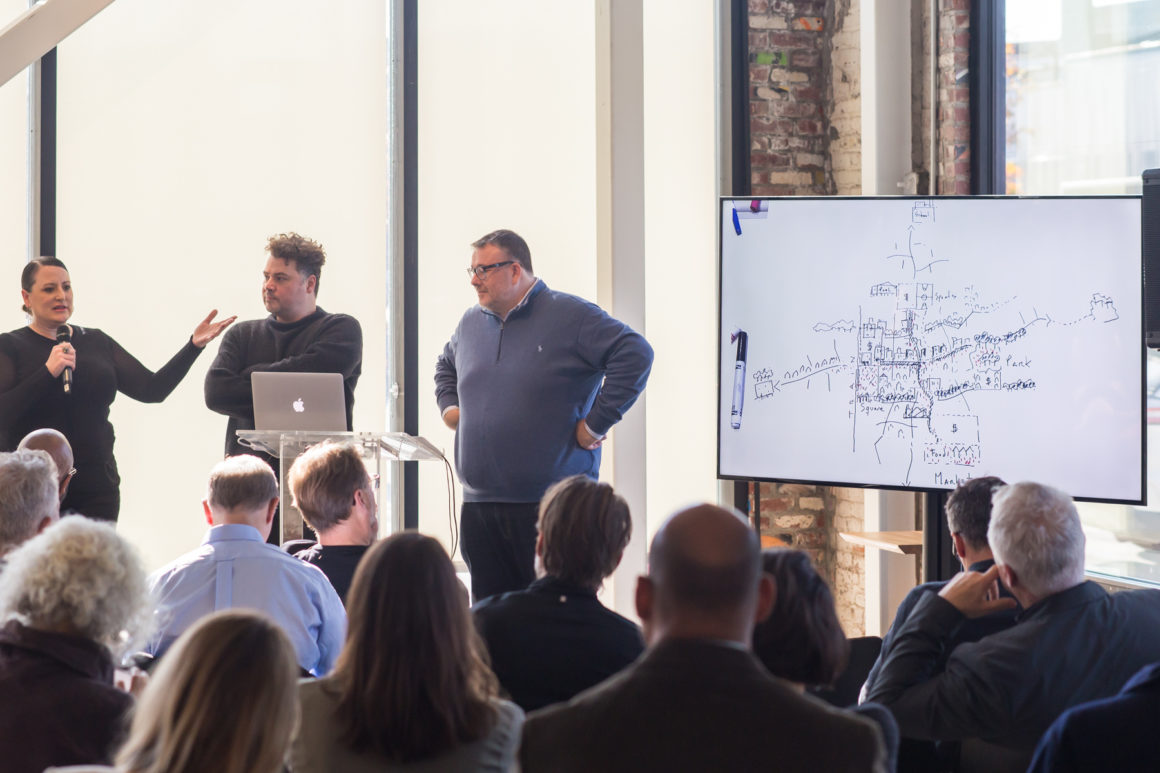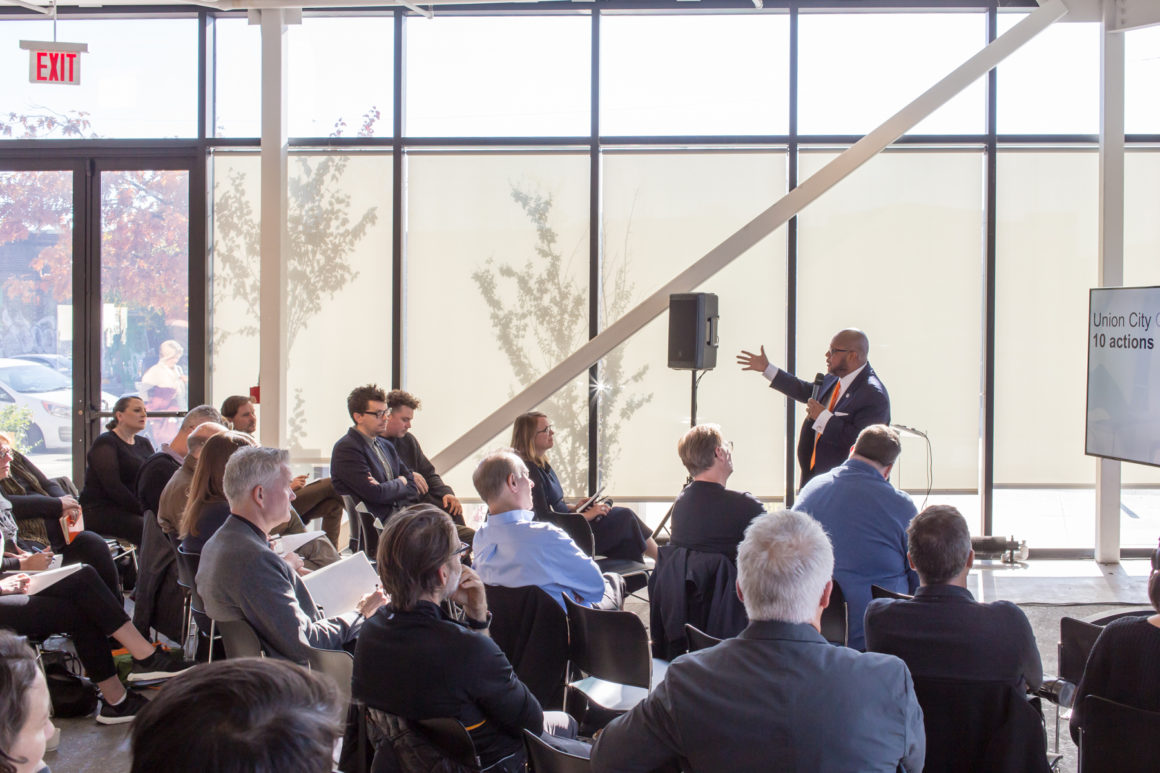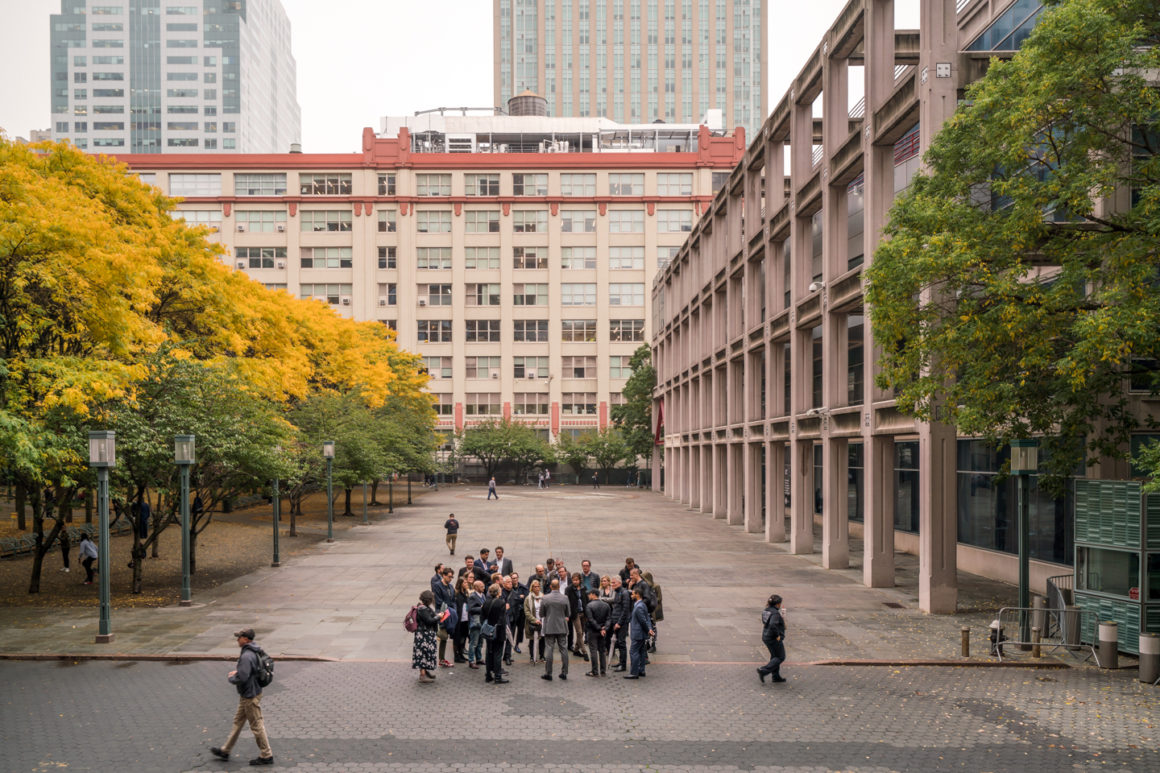
According to projections, New York City is set to increase by another 500,000 residents over the next two decades. The impacts of this growth, coupled by shrinking municipal coffers, promise to exacerbate the City’s challenges around aging infrastructure, a severe housing crisis, and income inequality. In response, New York and other global cities are looking for creative ways to leverage private money to meet the needs of their swelling populations.
From the creation of parks and open space, to the development of entirely new neighborhoods, private interests are shaping our spatial city more than ever before. This reality underscores the importance of balancing private investment with public benefit. What best practices can guide collaboration across the public, private, and design sectors to ensure the most equitable outcomes? This question is at the core of Van Alen’s work helping cities understand what change is needed and how to make it happen.
The International Council traveled to London in Spring 2019 to probe this question and foster learning across cities, by examining two case studies: Kings Cross and Olympic Park. Equipped with lessons on London’s approach to benefits and tradeoffs, the Council continued their exploration in New York City in Fall 2019. They focused on Brooklyn as an epicenter of creativity and change—one that Van Alen will be joining when the organization relocates to the borough’s neighborhood of Gowanus in Spring 2020.
Over the past two decades, the Brooklyn brand has risen to global prominence, as it’s become a driving force behind the innovation economy—a set of industries related to technology, creativity, and new-age manufacturing. This growth has generated immense economic investment and opportunity, contributing to Brooklyn’s dynamism, while also raising the critical question of “who benefits?” that fuels a citywide public debate.
The Council directed their attention to Downtown Brooklyn and Sunset Park, two neighborhoods that differ dramatically from the master-planned swaths of London that have the advantages of single, large-scale land ownership. Both case studies are hubs of the emerging innovation economy and reflect the complex conditions that underpin Brooklyn’s evolution.
The central and transit-rich district of Downtown Brooklyn was historically a lively commercial and civic center. Through decades of decline, it was underutilized and seen as prime for revitalization. The City rezoned the area in 2004 with the vision of creating a new, 21st century Central Business District (CBD) that would service the growing borough and greater metropolitan region.
The surge of investment that followed, successfully stimulated development and generated job growth, making it the city’s third largest CBD. The unplanned proliferation of residential alongside commercial, however, put tremendous pressure on its existing infrastructure. As a relatively new district, Downtown Brooklyn is now finding its footing in balancing future growth with the needs of its new 24-hour, mixed-use community.
To ground the Council’s work in history, Deborah Schwartz, President of the Brooklyn Historical Society (BHS), gave the group an overview of the borough’s development—noting that Brooklyn’s physical boundaries have changed over time. “Had you been in this very space in the 18th century you would have been in the water,” she said, speaking from BHS’s space in the waterfront neighborhood of Dumbo. “A huge part of New York’s and Brooklyn’s history is about landfill. It’s really important that people understand the evolution of how this city grows and changes.” She added that it’s not just development that’s affecting the coastal boundaries of the borough: “Because of the realities of rising waters, the politics of global warming are a huge part of what’s informing how people build things here.”
At the Dumbo offices of Bjarke Ingels Group (BIG), Winston von Engel, Director of the Department of City Planning’s Brooklyn office, gave the group an overview of New York City’s complex planning and zoning processes, which are starkly different from the master planning approach taken in many of the countries that Council members hail from. He put this in context of New York’s steady rise in population and the subsequent pressure for increased housing and density. “We got to a point in the mid-2000s where we had to ask: Where are these people going to live if we’re not growing upward or outward?”
He explained that the city developed PlaNYC (since updated to the strategic plan OneNYC), a more comprehensive vision for growth that anticipated a population of nine million people by 2030. The transit system was a key factor in PlaNYC, as the City identified neighborhoods with enough transportation access to support growth. Sitting at the intersection of 13 subway lines and with quick access to Manhattan, Downtown Brooklyn was an obvious focus for new development, especially following its rezoning in the early 2000s.
In contrast to London or other similar European cities, development in New York does not happen by way of a citywide master plan, a fact that some Council members found bewildering at times. Von Engel acknowledged the difficulty that comes with the complex web of planning in New York, which involves the collaboration of several city agencies and the input of community boards—appointed citizen advisory groups that often have an adversarial relationship with private developers. Increasing density requires “working through and with communities in partnership to come up with plans and visions for their future,” said von Engel. That process of partnership can be met with “somewhat mixed success in terms of the communities’ reception to more people moving in. People want good things, but they may not want things to change.”
On a walk from BIG’s offices to the Downtown Brooklyn core, the Council heard from Regina Myer, President of the Downtown Brooklyn Partnership, a non-profit development organization that describes itself as “the local champions for Downtown Brooklyn.” As the group moved from the cobblestone streets of Dumbo to the unmissable cluster of new high-rise buildings in Downtown Brooklyn, Myer put the amount of growth into stark relief. After 15 years of growth since the neighborhood’s rezoning, “There’s been over ten billion dollars’ worth and over 26 million square feet of development, mostly in apartments,” she said. “We are now projecting 50,000 residents in Downtown Brooklyn. We had less than a thousand 15 years ago. This is a phenomenal shift.”
She acknowledged that there have been surprises along the way—namely, that the development has been far more residential than originally envisioned. “We had a great expectation that many of them would have offices located in the buildings and that was a miscalculation of the market.” The upside, as she sees it, is that Downtown Brooklyn has a multipurpose texture that doesn’t feel like a cluster of offices. “What we’re so excited about is the mix of uses between school, office, and residential. And for the first time Downtown Brooklyn has hotels. There literally was no hotel use in Downtown Brooklyn until about 15 years ago, and now this is a place where many people come to stay when they’re visiting New York City.”
Looking ahead to the next phase of growth, the Downtown Brooklyn Partnership has engaged BIG and architecture firm WXY to imagine a system that will better knit together the neighborhood amidst this massive change and bring a more pedestrian-friendly feeling to the streets. Although their plan is still under development, Kate Cella, Senior Landscape Architect at BIG, shared that the complex intersection of streets and multiple forms of transportation will be addressed. “These multiple grids from different neighborhoods all converge in Downtown Brooklyn and that can disorient you,” she acknowledged. “There’s a lot of congestion and multimodal complexes since it’s a major thoroughfare for subway, buses, cars, pedestrians, cyclists, for everyone.” In response, their plan will prioritize pedestrians, buses, and bike lanes, and propose an increase in public seating areas and greenery.
During the tour and at a roundtable discussion held in the Brooklyn Academy of Music’s historic Harvey Theater, Council members probed further into New York’s complicated city planning process and questioned how the public’s interest could be honored without an officially appointed entity—like a city architect—dedicated to preserving the city’s character and interests of its residents.
“You need a singular entity that’s always acting in the public interest to catalyze urban change on a big scale,” observed Daniel Elsea, International Council Co-chair and director at UK-based urban planning firm Allies & Morrison. “[In New York] there isn’t a single entity that can negotiate all those issues into one. There’s a lot of fragmentation.”
Council member Morten Schmidt, founding partner of Schmidt Hammer Lassen Architects, added that this fragmentation can put the unique architectural character of a neighborhood at risk. “The materiality of Brooklyn’s historical buildings is beautiful, rendered in brick and brownstone. But when you look around, these new buildings are just glass and aluminum. They don’t have that materiality. They are like all the other buildings you find across North America, China, Australia—all over. If you were dropped here, you wouldn’t be able to tell where you are.”
Because many of Downtown Brooklyn’s new high-rises are largely market rate and luxury housing, the Council also discussed how this growth would affect long-term stability in New York. They observed how similar growth has happened in other global centers such as London and Paris, resulting in an increasingly expensive urban core with lower income residents being pushed toward the edges of the city. “You either pay people enough money to compete in the housing market, or you subsidize the production of housing,” a Council member asserted during the discussion. “And if you don’t do either of those things, which we don’t, then you’re going to end up with a housing crisis.”
The challenge of maintaining New York City’s competitive edge, while ensuring equitable development is also playing out in the South Brooklyn neighborhood of Sunset Park. This long standing immigrant neighborhood is closely linked to the history of manufacturing along its wateront, which provided jobs to much of the upland community.
As the post-industrial shoreline has undergone a renaissance, commercial pressures in Sunset Park have intensified in recent years. Industry City is a privately-owned campus and anchor tenant of the evolving waterfront that has come to represent the new-age innovation economy accused of supplanting traditional manufacturing and spurring wider neighborhood change. This 19th-century complex of warehouses that spans 35-acre has been transformed into a hub for light manufacturing, commerce, and special events.
In the face of a rezoning request by Industry City to introduce hotel and big-box retail to the complex, a fiery debate has unfolded about whether to resist the request outright or leverage private development in order to achieve community benefits.
The Council started the day with a tour of upland Sunset Park, the residential area that grew out of the nearby waterfront industry and has long been home to New York’s many waves of immigrant families. Melissa Del Valle Ortiz, Community & Housing Coordinator for Congresswoman Nydia M. Velazquez, pointed out a new mixed-use building that had replaced a residential brownstone, and shared that even small-scale change in character like this can cause community tension in a lower income neighborhood facing rising housing costs.
Later in the day, the Council engaged in a lively discussion with New York City Councilmember Carlos Menchaca, whose district includes Sunset Park and has been a central figure in the debate around Industry City’s proposed rezoning. Much of the conversation centered around the challenging, often adversarial relationship between communities and private developers. “The community often gets blinded by the power, resources, and time that developers have,” said Menchaca. “Starting with ‘no’ sends a clear message that the burden is on the developer to get to ‘yes.’ It doesn’t feel good as a developer and maybe that’s the point.”
Renae Widdison, District 38’s Director of Land Use and Planning, added, “It’s about whose vision is starting the conversation. Especially in communities where people are housing insecure and feel constantly excluded from government and everything else, the conversation has to start somewhere different.” She posed a scenario in which private developers approach community members with an open question about what they need and where their mutual benefits intersect. “That’s really different than a developer coming with a very baked plan with fancy renderings and very expensive lawyers, planners, and designers, saying ‘I think that this would be excellent for you.’”
Both Menchaca and Widdison echoed the Council’s concerns about the lack of a larger master plan for development in New York. “We are in a status quo that is void of a comprehensive plan.” said Menchaca. “These piecemeal strategies just don’t work.”
Mulling over the conversation, Carmen Pereira, Associate Partner at international design practice Mecanoo, compared her learnings to her experience in the Netherlands. “Designing a process that adequately can bring all these different ideas, voices, and objectives together is a much bigger thing. It goes to the heart of people’s views of the democratic process and the idea of the individual versus the collective. What I see here in the U.S. or in New York is that the idea of the individual is a very powerful thing, but the idea of the collective is somewhat diminished.”
She continued, “There’s no perfect system. But [in the Netherlands] things are considered in a much larger totality. There’s definitely a lot of possibility for engagement in that process. The collective is considered more important than the individual.”
Monica von Schmalensee, International Council Co-chair and CEO of Swedish firm White Arkitekter, also considered the delicate balance between growth and community needs. “How do you create social value and economic value, but also a long-term vision?” she pondered. “These discussions about how cities evolve—whether through planning, negotiation, or just that big deal—have been an eye-opener. How can architects and planners help those processes go forward while really helping local communities? The field needs to put these questions higher up on the agenda.”
Concurrently with the Council’s trip to Brooklyn, Van Alen hosted a 2019 Regional Session of the Mayors’ Institute on City Design (MICD). During this session, civic leaders from small U.S. cities and group of global design professionals convened to discuss approaches to city-making at all scales.
As a special capstone to the week, Van Alen brought together some of the participating mayors with the Council for an ideas exchange. The day before, the Council gathered at the Center for Architecture for a fast-paced design charrette addressing specific challenges in each mayor’s home city: Maricopa, AZ; Capitol Heights, MD; Union City, GA; and West Hollywood, CA. The ideas were then presented to the mayors—not as formal recommendations, but as a starting point for conversations between leaders in citymaking and design.
Shawn Maldon, Mayor of Capitol Heights, MD, expressed his hope to find ways to improve public health and encourage more community engagement in his city’s downtown revitalization process. He was excited to see the Council’s proposal to convert a large portion of the city’s downtown into a public park, and imagined that a new vision of a park could really engage citizens in the planning process. “We as mayors have these big visions of how we’d like to see things happen,” he reflected. “But sometimes it’s good to come back down to earth and have some real hands on kind of help to make it happen.”
Christian Price, Mayor of Maricopa, GA, brought several challenges to the table. As a city that’s skyrocketed from a population of 1,200 to 54,000 since 2000, he’s faced with finding developers willing to create new amenities from the ground up, while also finding ways to enable more outdoor activity in Arizona’s hot climate. The Council took a long term view for this challenge and recommended investing in public park space, which would provide shady green areas, create a more intentionally-planned sense of place, and serve as appealing new assets for potential developers.
Following the presentation, Mayor Price expressed a new appreciation for design thinking and an eagerness to bring his learnings back to his city. “I’ve been educated, now how do I educate?” he asked. “We need to create a fire and that fire’s going to come by educating my city manager, my upper echelon of city staff. Having a design team that we can pull locally into that philosophy might be really interesting.”
Deborah Marton, Van Alen’s executive director, echoed this sentiment in her closing remarks to the mayors. “There’s extraordinary generosity among designers. Designers want to put their minds to real world problems. If you find people in your local communities who think the way you do, they will raise their hands and help build the cities that you want to see for the long term.”
While the trip provided the International Council with a bevy of answers about the ins and outs of Brooklyn’s development, Council members often found themselves wrestling with questions at the highest level, especially around the intersection of social and environmental issues. “We started our conversation around equity and quality of life, but somewhat vaguely,” said Monica von Schmalensee. “But over time, we’ve been able to dig more into the big questions ahead of us. How do cities grow, and for whom? And what does it mean to make cities more equitable?”
“It’s important that we bring more of the climate discussion into social discussions,” added Carl Backstrand, Partner & Vice President, White Arkitekter. “We really need to address them together in order to shape the future.”
Other participants found inspiration in the potential for private-public collaborations, but reinforced the need for more cross-city dialogue, interdisciplinary learning, and inclusive conversations about the future of urban design. “I had a very different understanding of private developers roles in cities,” one Council member noted. “I was leaning more towards the negative side of things. One of my takeaways is actually under the right circumstances, [private development] can be used to generate positive things for cities and placemaking—in partnership with governance and other voices.”
“There’s still a lot of work to be done in bridging the gap between the [design] industry and city governance,” observed Lucie Murray, Programme Director of New London Architecture, the International Council’s partner organization during their London expedition. “There’s so much talent to pull upon, but we need to get the right people in the room to have a conversation about the solutions—and to have the confidence to take some big leaps.”
CLIMATE COUNCIL PARTICIPANTS
Pat Arnett, Silman
Carl Bäckstrand, White Arkitekter (Council Co-Chair)
Luis Becker, Henning Larsen
Alice Brittion, Squint Opera
Alfredo Caraballo, Allies and Morrison (Council Co-Chair)
Niklas Carlen, Wingardhs
Jonas Edblad, Wingardhs
Daniel Elsea, Allies and Morrison (Council Co-Chair)
Karen Frome, Silman
Benjamin Garcia Saxe, Studio Saxe
Denzil Gallagher, BuroHappold
Amalia Gonzalez Dahl, Henning Larsen
Tony Grist, HASSELL
Nancy Hudson, Silman
Scott Hughes, Silman
Hauke Jungiohann, BuroHappold
Sara Navrady, Mecanoo
Nat Oppenheimer, Silman
Carmen Pereira, Mecanoo
Sara Rubenstein, Henning Larsen
Monica von Schmalensee, White Arkitekter (Council Co-Chair)
Morten Schmidt, Schmidt Hammer Lassen
Michael Sorensen, Henning Larsen
Thomas Stokke, Haptic
GUEST PARTICIPANTS
David Burney, Pratt Institute School of Architecture
Matthew Carmona, Barlett School of Planning
Kate Cella, BIG
Connie Chan, NYC Department of Planning
John D’Amico, Mayor, West Hollywood, CA
Melissa Del Valle Ortiz, Office of Congresswoman Nydia M. Velázquez
Jared Della Valle, Alloy
Patrice Derrington, Columbia GSAPP
Alireza Esmaeilzadeh, Brookfield Properties
Justin Garrett Moore, NYC Public Design Commission
Jamie Ginsberg, Empire Stores
Sagi Golan, NYC Department of City Planning
Paul van der Grient, WXY
Jonathan Jones, BAM
Andrew Kimball, Industry City
Matthew Kwatinetz, NYC EDC
Sharon Lehner, BAM
David Lombino, Two Trees Management
David Lowin, Brooklyn Bridge Park Development Corporation
Shawn Maldon, Mayor, Capitol Heights, MD
Carlos Menchaca, New York City Council, District 38
Cara Michell, WXY
Admir Molic, Brooklyn Greenway Initiative
Regina Myer, Downtown Brooklyn Partnership
Daniel Payne, AEA Consulting
Christian Price, Mayor, Maricopa, AZ
Thomasin Renshaw, Grosvenor
Miguel Robles-Durán, The New School and Cohabitation Strategies
Gustavo Rodriguez, FXCollaborative
Michael Samuelian, Trust for Governors Island
Deborah Schwartz, Brooklyn Historical Society
Andrea Steele, Andrea Steele Architecture
Keith Stubblefield, BAM
Paul Travis, Washington Square Partners
Winston von Engel, NYC Department of Planning
Dan Wiley, Office of Congresswoman Nydia M. Velázquez
Vince Williams, Mayor, Union City, GA
